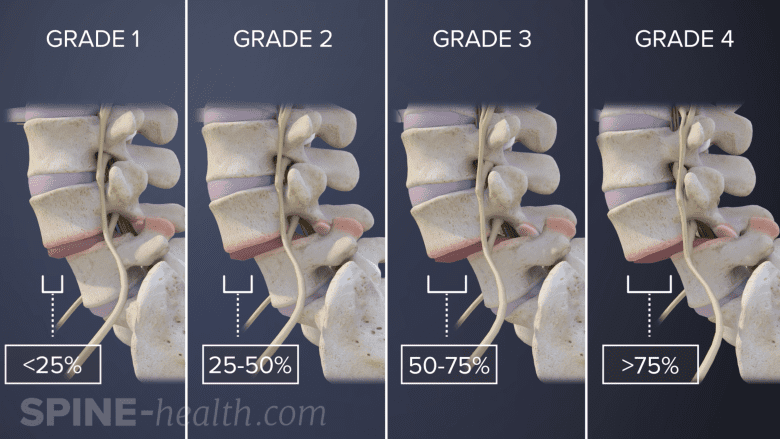What does the term "spondy" actually mean, and why are there so many similar-sounding spine conditions?
The prefix "spondy-" derives from the Greek word "spondylos" (σπόνδυλος), which means "vertebra" or "vertebral joint."
In its original form, the term refers to the bones that make up the spinal column. This root is commonly used in medical terminology to denote conditions related to the vertebrae or spine.
1. Spondylosis
A common age-related condition where the spine experiences wear and tear, leading to arthritis-like changes, stiffness, and sometimes nerve compression. Spondylosis is common in adults over age 60 and typically occurs in the neck and/or lower back.
This term is sometimes used interchangeably with spinal osteoarthritis.
2. Spondylolysis
This is a small stress fracture or crack in the pars interarticularis, a part of the back of a vertebra, which can cause pain and sometimes instability. Spondylolysis most commonly occurs in the lower back.
Spondylolysis is relatively common in young athletes and adolescents, especially when they are involved in sports with repetitive backward bending of the spine such as gymnastics, volleyball and dance.
3. Spondylolisthesis
This is a relatively common condition in which one vertebra slips forward over the one below it, potentially causing back pain and nerve symptoms.
Spondylolisthesis may be due to:
- A break of the pars interarticular (spondylolysis) - called isthmic spondylolisthesis
- Degenerative changes in the spine - called degenerative spondylolisthesis
Most cases occur in the lower lumbar spine, especially in one or both of lowest two spinal motion segments called the L4-L5 and L5-S1. Spondylolisthesis is measured by how much the vertebra has slipped and graded on a scale of 1 to 4.

The 4 Grades of Spondylolisthesis by Slippage Percentage
4. Spondyloptosis
This is a severe form of spondylolisthesis where a vertebra completely slips off the one below it.
Spondyloptosis is rare and usually represents the end stage of untreated or severe spondylolisthesis.
- Grade 4 spondylolisthesis means the vertebra has slipped forward up 76% - 100%, but it is still partially aligned
- Grade 5 spondylolisthesis is called spondyloptosis, which means the vertebra has fully fallen off the vertebra below it
Most cases of spondyloptosis occur in the lumbar spine, especially at the bottom spinal motion segment L5-S1. This diagnosis creates a high degree of instability at the affected spinal motion segment and often requires surgery.
5. Spondylitis
This term means inflammation of the vertebrae, often caused by autoimmune diseases, which can result in pain and stiffness in the spine.
Ankylosing spondylitis is the most common type of spondylitis.
Ankylosing spondylitis most often starts in the sacroiliac joints at the base of the spine and can spread to additional parts and/or the entire spine.
6. Spondyloarthropathy
This is a broad term for a group of inflammatory joint diseases that mainly affect the spine and nearby joints, causing pain and stiffness.
Spondyloarthropathies include conditions like ankylosing spondylitis, psoriatic arthritis, and reactive arthritis.
A spondyloarthropathy condition can affect the entire spine or just part of it and may also involve the sacroiliac joints and peripheral joints.
7. Spondylosis Deformans
A degenerative condition where bone spurs form along the edges of vertebrae, which can cause stiffness and discomfort.
This condition is more commonly referred to as bone spurs or osteophytes.
Bone spurs are common in older adults and often are not a problem. If they do cause pain and stiffness, it is usually diagnosed as a part of spinal osteoarthritis (also sometimes called spondylosis).
8. Spondylodiscitis
An infection that affects both the vertebra and the disc between them, leading to inflammation, pain, and sometimes spinal instability.
Spondylodiscitis is rare but serious, typically occurring in older adults, people with weakened immune systems, and possibly after spinal surgery.
A related term is vertebral osteomyelitis, but they are distinct diagnoses:
- Spondylodiscitis - Infection and inflammation that involves both the intervertebral disc (discitis) and the adjacent vertebral bodies, including the vertebral endplates.
- Vertebral osteomyelitis - Infection and inflammation of the vertebral body (the bony building blocks in the spine)
The term discitis alone is less common because isolated infection of the disc is rare; usually, the infection starts in the vertebral endplate and spreads to the disc.
Understanding these eight "spondy-" conditions provides valuable insight for you to both understand your clinical diagnosis and to seek appropriate treatment.

